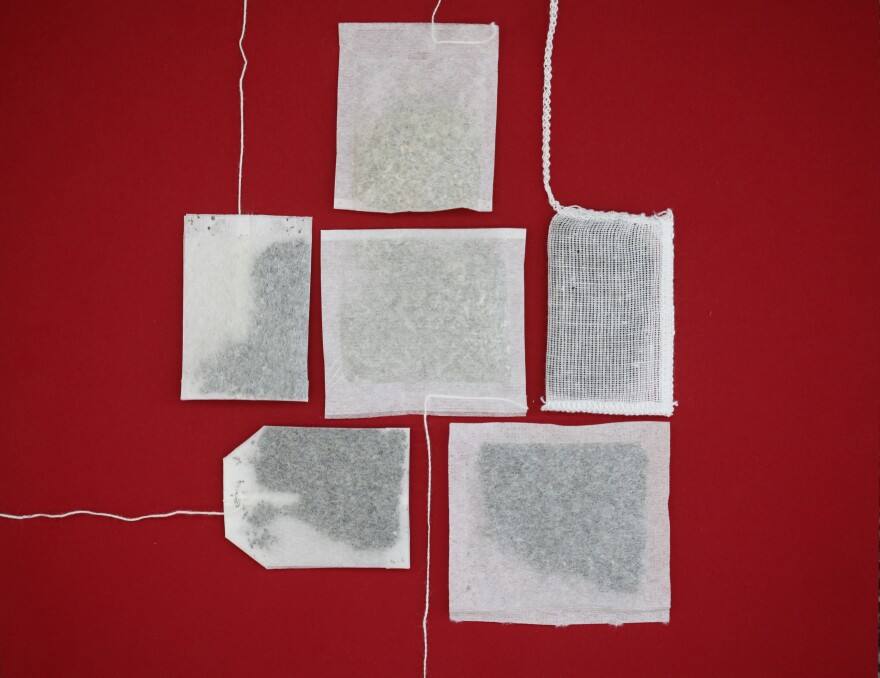People have been drinking tea for so long that its origin story is rooted in mythology: More than 4,700 years ago, one popular version of the story goes, a legendary Chinese emperor and cultural hero named Shennong (his name means "divine farmer") discovered how to make a tea infusion when a wind blew leaves from a nearby bush into the water he was boiling.
By the 4th century B.C., as Jamie Shallock writes in his book Tea, the beverage had become part of everyday life in China — though in a very different form than we might recognize today.
As the culture surrounding tea has changed through the centuries, so, too, have the tools we use to drink it. From the first dainty tea bowls to the mugs people use to warm themselves with a cup of tea today, tea sets have changed to meet cultural and utilitarian needs.
Before 1500
The first tea leaves weren't drunk in loose form; instead, they were compressed into cakes. To prepare tea, early drinkers had to tear off a piece of the compressed brick (often stamped with intricate patterns, and so valuable that it could be used in lieu of currency), roast it and tear it into even smaller pieces. Then they boiled their tea in heat-resistant kettles. According to Rupert Faulkner's book Tea: East & West, by the Song Dynasty (960-1279), tea had moved into a powdered form that could be set in a cup and whipped into the boiling water poured onto it. This whipped tea is most commonly associated with Japanese tea ceremonies today.
A proper tea service could include 25 objects, according to Lu Yu, whose seminal 8th century book, The Classic of Tea, is the authority for early drinking habits. But the most important of these was the tea bowl. These glazed, ceramic vessels were simple in shape and tended to be between two and three inches in height.
1500s
By the 1500s, powdered and whipped tea had given way to steeped tea, which came in the form of rolled leaves rather than bricks. This necessitated the invention and use of the teapot as we know it today. These first teapots, James Norwood Pratt writes in A Tea Lover's Treasury, came from the Yi-Xing region of China and were soon copied throughout the world. Japanese potters moved the handle from the side to the top of the teapot.
1700s
Tea finally reached Europe in the 1600s, along with the necessary tea wares manufactured in Japan and China. As English potters began to adapt the tea set to their countrymen's tastes, they eventually added a handle to the tea bowl to protect fingers from the transmission of heat through the delicate porcelain. According to Steeped in History, edited by Beatrice Hohenegger, this "became necessary because of the British habit of drinking hot black tea, which is consumed at higher temperatures than Chinese green." The English based the new design off existing large, handled mugs and containers used for hot beverages. The size of teacups also grew to accommodate the English taste for milk and sugar in their tea.
However, Christina Prescott-Walker, a European ceramics expert and the director of the Chinese ceramics department at Sotheby's, believes the invention of the handle may have been a fashion statement more than a utilitarian choice. "In England, tea bowls were still being made as late as 1800," she tells The Salt. Faulkner writes in his book that the original bowls were perceived as more "authentically oriental" than their handled cousins.
1920s
By the early 1900s, innovations in tea drinking became an American affair. The most revolutionary was the tea bag, which was accidentally commercialized by a tea merchant named Thomas Sullivan. He had been sending customers tea wrapped in silk, and rather than take the leaves out of the bag, as Sullivan intended, the customers put the bags into their teapots instead. According to Faulkner, not only did the tea bags push the teapot back to the sidelines of tea service, they were too large for teacups and ushered in the modern practice of drinking tea from large mugs.

Today
Today's designers are thinking up ways to integrate technology into our tea. Take, for example, Playful Self, a new exhibition piece at the Dublin Science Gallery. The tea set – which is still far from commercial use — responds to and collects biometric data from the user, including heart rate, breathing rate and even sweat production. From bowls to biosensors, the tea set has come a long way.

Tea Tuesdays is an occasional series exploring the science, history, culture and economics of this ancient brewed beverage.
Tove Danovich is a writer based in New York City.
Copyright 2023 NPR. To see more, visit https://www.npr.org.


